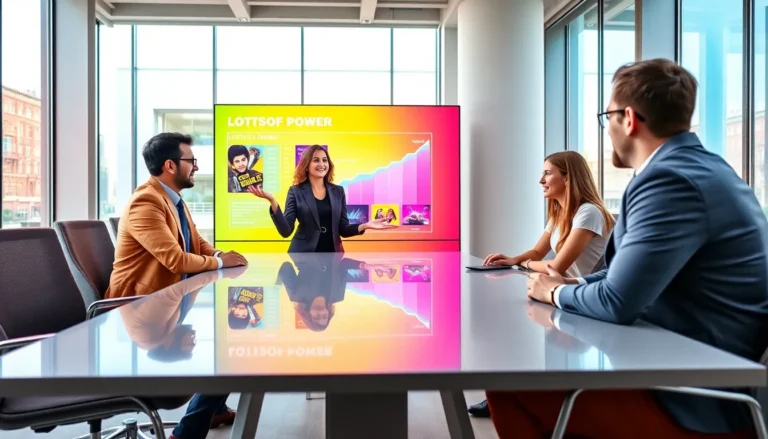In a world where bigger isn’t always better, tiny houses are stealing the spotlight. Imagine cozy living spaces that maximize every square inch, all while keeping your wallet happy. But how do you turn that dream into a reality? Enter tiny house 3D planning, the magical tool that transforms your compact castle ideas into a digital masterpiece.
Table of Contents
ToggleOverview of Tiny House 3D Planning
Tiny house 3D planning offers an innovative approach to designing compact living spaces. This digital design tool allows individuals to create detailed and accurate representations of tiny houses. With 3D planning software, users visualize layouts, test different furniture arrangements, and explore color schemes.
Users can manipulate dimensions and features in real-time, ensuring that their designs meet specific needs. Software options include customizable templates, allowing individuals to adapt existing structures or start from scratch. Three-dimensional models provide a clearer understanding of space utilization, helping avoid design flaws before construction begins.
Many programs feature an intuitive interface, making them accessible to both beginners and experienced designers. Integrating building codes and regulations into the planning process is another advantage, ensuring that designs comply for safety and legality. These tools often incorporate a library of materials and finishes, simplifying the selection process for homeowners.
Incorporating advanced rendering capabilities enhances the overall experience. This technology generates realistic visuals of lighting, materials, and spatial relationships. As a result, individuals can make informed decisions about design elements that work together harmoniously.
When creating a tiny house, 3D planning enables individuals to visualize their ideas clearly. It facilitates collaboration among homeowners, architects, and builders, streamlining communication between all parties involved. With its ability to transform concepts into three-dimensional models, tiny house 3D planning proves invaluable for anyone looking to optimize their small living space effectively.
Benefits of 3D Planning for Tiny Houses
Tiny house 3D planning brings significant advantages, enhancing the design process for compact living spaces.
Enhanced Visualization
Visualization becomes more precise with 3D planning tools. Homeowners can explore their tiny house designs in a three-dimensional space, making modifications easier. Users gain the ability to view different materials and colors, leading to well-informed choices. Creating realistic renderings allows people to identify potential design flaws before construction begins. Clients also feel more connected to their projects as they visualize their future homes, promoting confidence in the design choices made.
Improved Efficiency
Efficiency increases significantly through the planning process offered by 3D software. Making timely adjustments to layouts saves time and resources, eliminating costly mistakes. Individuals can experiment with varying room dimensions and furniture placements, optimizing space utilization. Collaborating with builders and architects becomes streamlined, facilitating effective communication. These tools come equipped with templates that conform to building codes, ensuring that designs meet safety standards. Reducing the time spent on revisions leads to an overall smoother project timeline, enhancing the tiny house planning experience.
Key Features of Tiny House 3D Planning Tools
Tiny house 3D planning tools offer essential features that simplify the design process, enhancing user experience in creating compact living spaces. Key components include customization options and user-friendly interfaces.
Customization Options
Customization options provide flexibility during the design phase. Users can choose from a variety of floor plans, materials, and finishes to suit their preferences. This feature allows for adjustments to dimensions, enabling the creation of unique layouts that maximize available space. Users can also incorporate personal touches, such as specific color palettes and furniture styles, ensuring the design reflects individual tastes. Many tools offer pre-made templates tailored to tiny houses, streamlining the process while allowing for personalization.
User-Friendly Interfaces
User-friendly interfaces enhance accessibility for both novice and experienced designers. Simple navigation aids users in moving through different views and features without difficulty. Intuitive controls enable rapid adjustments, significantly reducing the learning curve. In addition, many platforms offer tutorial resources, guiding users in maximizing the software’s potential. Engaging visuals help users visualize their designs in three-dimensional space, making the planning process enjoyable and efficient. Overall, these interfaces facilitate a smooth design experience for tiny house projects.
Popular Tiny House 3D Planning Software
Many tiny house enthusiasts rely on specialized 3D planning software to transform their ideas into detailed designs. Several tools stand out in this area, offering unique features and user experiences.
Tool Comparison
SketchUp, as a widely recognized option, provides powerful modeling capabilities, suitable for both beginners and experts. RoomSketcher is user-friendly and focuses on drag-and-drop functionality, making it accessible for all skill levels. Home Designer Suite combines advanced features with a more extensive library of materials, which appeals to seasoned designers. Live Home 3D offers real-time rendering technology that enhances visualization quality. Planner 5D, known for its simplicity, enables users to create designs quickly, though it may lack some depth in advanced features. Each tool presents a unique blend of functionality, emphasis on usability, and available resources, making careful comparison essential when selecting the right fit.
Pricing and Accessibility
Pricing structures vary among popular tiny house 3D planning software. SketchUp offers a free version, but the full capabilities come with subscription plans starting around $299 per year. RoomSketcher provides a free basic option, with premium features accessible through additional costs. Home Designer Suite typically costs around $49.99 for the standard version. Live Home 3D permits a one-time purchase of approximately $19.99, while Planner 5D offers a free version with in-app purchases available. Accessibility often extends to both desktop and mobile devices, ensuring users can create on their preferred platforms. Budget considerations pair closely with the specific needs of the project and available features.
Conclusion
Tiny house 3D planning is revolutionizing the way individuals approach compact living. By leveraging advanced software tools, users can transform their visions into practical designs that maximize space and efficiency. The ability to visualize layouts and make real-time adjustments empowers homeowners to create personalized living environments that meet their unique needs.
As the tiny house movement continues to grow, embracing 3D planning tools becomes essential for anyone looking to embark on this journey. With the right software, the design process becomes not only easier but also more enjoyable. By investing time in planning, individuals can ensure their tiny homes are both functional and reflective of their personal style, paving the way for a successful and fulfilling tiny living experience.







